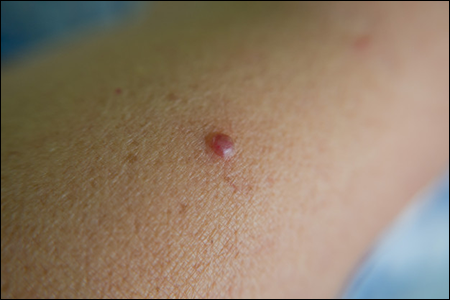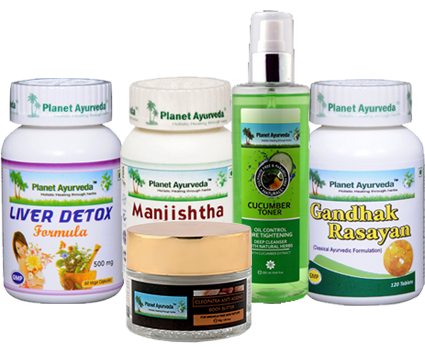Treatment of Cherry Angioma in Ayurveda with Herbal Remedies
Abstract
"Healthy skin is the reflection of overall wellness".
Skin is the largest outer organ of the human body as it covers the whole body surface from outside. There is an increase in skin disorders due to the lifestyle and dietary habits which show direct or indirect effects on the skin. Cherry angioma is one of such common skin conditions which is presented in the mole shaped growth in the skin on any part of the body, appearing like reddish or purple colored lesions. Let's have a little deep knowledge about the disease, its causes & symptoms and the herbal solution for the disease with Ayurveda.
Introduction
Cherry angioma is a benign tumor of the capillaries which generally tends to increase as the affected individual advances in age. The lesions appear as cherry-reddish skin growth, having smooth texture that results from no definite overgrowth of small blood vessels beneath the skin (i.e. capillaries)
These are bright red, oval or circular in shape, small moles that can be raised or may be presented with a flattened surface anywhere on the body. The most common sites of appearance of moles is the torso, and greatly affect the limbs (both upper & lower), chest, abdomen and back. In rare cases, the involvement of the scalp is there. The characteristic feature of the disease is the presence of Campbell de Morgan spots (named after British Surgeon who firstly described this condition). These are basically characterized by red or purple moles appearing as a result of proliferation of blood vessels.

Causes
Exact etiology of this disease is still unknown. But there are some possible risk factors. Those are as
- Genetic involvement: Somatic mutations in GNAQ and GNA11 genes are considered to be responsible for this disease.
- Aging: These spots/angiomas are believed to be associated with aging, affecting elderly aged more than 40 years. With advancing age the quantity and size of the moles tends to increase.
- Direct exposure of skin cells to mustard gas, bromides like hazardous chemicals.
- Over responsive behavior of mast cells.
- After pregnancy: due to hormonal changes such as increased prolactin levels after the delivery of a child.
- May be present as an early sign of some systemic disease of liver/kidney or heart related.
- Climatic change is also believed to be an important factor.
Sign & Symptoms
- As discussed in the introduction part the main feature is the presence of Campbell de Morgan spots anywhere on the body.
- The size of the moles can vary, generally ranging in dimensions from a pinpoint to about 1/4th of an inch in diameter.
- With the advancing size, these spots acquire a shape that looks like a dome with a flat top.
- There may be occasional bleeding from these moles as the redness in these angiomas are due to the overgrowth of capillaries. When these inflamed capillaries are being irritated by any means such as severe itching, external trauma or other environmental factors, they can start bleeding.
Ayurvedic Aspect
Skin is the outermost layer that covers the whole body parts & is termed as twacha in Ayurveda. Acharya Susrutha had described about twacha & its 7 layers in detail also including the various complications/ailments that were supposed to be arised in that layer in that particular layer in detail.
In contrast to this disease, the Lohita (second layer of twacha) is the layer which is considered to contain the capillaries. The relatable diseases that are usually presented in this layer are Tilakalak, Nyagach and vyang. The clinical appearance & nidana of these diseases are similar
Moreover, Acharyas had also mentioned that the various pitaj & raktaj vikar (diseases resulting from vitiation of pita & blood) may lead to various manifestations of skin related disease. Therefore it can be also concluded that these skin manifestations can be as a result of any ongoing or upcoming pathology in liver or spleen (seat of blood related micro channels).

Treatment of Cherry Angioma
The treatment procedure in Ayurveda can be concluded under 3 sub-headings, these are
- Nidana Parivarjana
- Shodhan Chikitsa
- Shanman Chikitsa
1. Nidana Parivarjana
Nidana Parivarjana includes the avoidance or stop over consumption of the causative factors. The causative factors according to Ayurveda are the pitta vardhak ahar vihar (diets & lifestyle aggravating pitta) which directly promotes the vitiation of blood due to ashryashribhav (mutual correlation between pitta & blood).
2. Shodhan Chikitsa
The shodhan chikitsa include the detoxification method for the whole body or local part.
Raktmokshan (Bloodletting) : For various blood related disorders, this purification method is best.
If the angiomas are present in a cluster or are big in size than others then the local detoxification can be done with bloodletting procedure such as jalokavacharan (leech therapy) or prachan karma (i.e. by minute cuts around the mole/lesions) and in case the papules are presented all over the body the bloodletting procedure siravedha is recommended. It is simply letting out the vitiated blood in a specific amount (decided according to the patients' body built, strength & digestive power).
Virechana Karma (Therapeutic purgation): There is no best treatment indicated for aggravated pitta as compared to Virechana karma. This procedure works at cellular level & cleansing the toxins & vitiated pitta from the body & thus aids healing of the various choronic to chronic skin as well as other pitta related disorders.
Shastra karma (Surgical excision): Shastra karma is also indicated for the chronic moles. But the after procedure of this Shastra karma is completely different from the conventional system, which makes it more effective & unique. After removing the mole the place is slowly given heat therapy with alkali or some other method, this will reduce the chances of recurrence of these angiomas to several folds.
3. Shaman Chikitsa
Shaman Chikitsa uses the oral medication & medicines for local applications. Shaman Chikitsa for this drug includes pittashamak yogs (formulation for quenching pitta dosha), raktashodhak dravyas (blood purifiers), yakritsudhikar dravya (drugs that aids detoxification of liver), and immune supporters.
Herbal remedies by our experts for the management of Cherry Angioma
Planet Ayurveda is A Leading Herbal Based Unit That Manufactures The Medicines That Are Obtained From 100% Natural Resources. The Various Formulations & Products That Are Made Here Are In The Strict Adherence To The Ayurvedic Texts. Moreover These Products Are Made On Ancient Time Tested Formulas And Under The Guidance Of Our Expert Ayurvedic Physicians.
- Manjishtha Capsules
- Gandhak Rasayan
- Liver Detox Formula
- Cucumber Toner
- Cleopatra anti-aging Body Butter
Product Description
1. Manjishtha Capsules
This is a standardized extract of Manjistha (Rubia Cordifolia) available in capsule formulation.This herb is known as Raktshodhak since Samhita periods means the blood purifying nature of this herb is known from a long time ago. In Cherry Angioma, the endotoxins are the basic cause of the vitiation of capillaries, due to its raktashodhak (blood detoxifying) property as a result of its hot potency & pungent vipaaka, these capsule pacifies the removal of toxins and effective action on balancing the pitta.
Dosage: 2 capsules, two times a day.
2. Gandhak Rasayan
SuddhaGandhaka (Detoxified & purified sulphur) is the basic ingredient of this drug along with some other herbal ingredients. The ingredients include Amalaki (Emblica officinalis), Shunti (Zingiber officinalis) and Godugdha (Cow milk) etc. These ingredients have been known for their anti-inflammatory, analgesic, mild detoxifying properties since ancient times.
As mentioned above, all the skin disorders are caused mainly due to the predominant vitiation of pitta dosha & rakta dhatu. Gandhak rasayan is believed to be one of the best remedies to treat the aggravated pitta due to the cool potency of Gandhak and Guduchi (Tinospora cordifolia) in it. Also, it contains various other herbs listed above that promotes its blood purifying ability, & helps in eliminating toxins from the body. Thus promoting the wellness of skin & aids in treatment of Cherry angioma.
Dosage: Two tablets, twice daily with plain water.
3. Liver Detox Formula
An efficient herbal formula made on the suggestion of our expert doctors available in capsule form. The ingredients include Haritaki (Terminalia chebula), Katuki (Picrorhiza kurroa), Makoy (Solanum nigrum), Kalmegh (Andrographis Paniculata) etc. The katuki, makoy and kalmegh are the best hepatoprotective drugs as described in Ayurvedic texts. Also it contains Haritaki & other similar drugs which facilitates in eliminating the toxins from the body. Thus, reducing the load & speeding up the normal functioning of the liver.
Hence, Liver Detox capsules are quite effective for managing this benign growth as the capsules can detoxify the liver, promote the health of the liver, thus maintaining the overall health of the body including skin ailments.
Dosage: Two capsules,twice daily after meals.
4. Cucumber Toner
Cucumber Toner and Cleopatra Butter are the best products manufactured by Planet Ayurveda for the tonicity of the skin. Cucumber toner has cucumber extract (Cucumis sativus), pudina (mint oil) and aloe vera like ingredients which are well known for their effects on the skin and skin cells.
Application
Cucumber Toner should be applied locally on affected part during day hours;
5. Cleopatra anti-aging Body Butter
Cleopatra butter has many ingredients including almond oil, shea butter, glycerine, aloe vera, which nourish the skin & aids the skin cells for faster recovery from the moles.
How to use
Cleopatra Butter should be applied during night hours.
Contact my assistant to provide you the costing / ordering and delivery information at - costing.planetayurveda@gmail.com or call at +91-172-5214030 Or Check Website - www.PlanetAyurveda.com
Conclusion
"Aging is the fact of life, looking aged is not". Thus, it must be our utmost priority to take care of our skin. Modern treatment advises the local application of corticosteroids but they will give temporary relief but on long-term use, they proved to damage the skin cell & hampered their normal functioning. Also if the steroid therapy is failed then surgical removal of the moles is advised. But the after the management of the surgical procedure is not that satisfactory & rate of recurrence is high. But in Ayurveda, the treatment of these type of angiomas are done with parasurgical methods (bloodletting procedures, virechana karma) or even surgical methods (shastra karma followed by slow burning with alkali or heat therapy), along with herbal remedies as suggested above, there will be lesser chances of recurrence & side effects. So, make your skin free from moles with ancient Ayurvedic herbs rather than harmful chemicals.


Comments